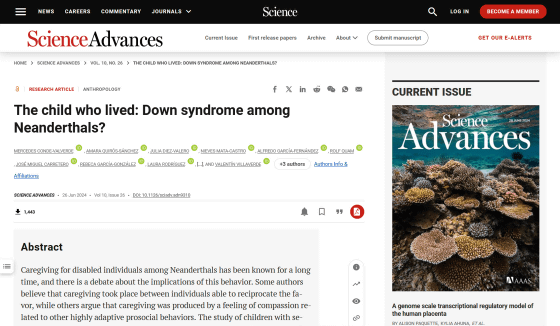It turns out that Neanderthals raised a 6-year-old child with Down's syndrome

The child who lived: Down syndrome among Neanderthals? | Science Advances
https://www.science.org/doi/10.1126/sciadv.adn9310

Bones reveals first evidence of Down syndrome in Neanderthals | Science | AAAS
https://www.science.org/content/article/bones-reveal-first-evidence-down-syndrome-neanderthals
First case of Down syndrome in Neanderthals documented | Newswise
https://www.newswise.com/articles/view/813341/
Neanderthals cared for 6-year-old with Down syndrome, fossil find reveals | Live Science
https://www.livescience.com/archaeology/neanderthals-cared-for-6-year-old-with-down-syndrome-fossil-find-reveals
In 1989, a right temporal bone of what is believed to be a Neanderthal child was unearthed in the Cova Negra cave in Xativa , Valencia , Spain, and is thought to be of the same age as other Neanderthal bones found in Cova Negra, which date from 273,000 to 146,000 years ago.
A research team led by the Universities of Alcalá and Valencia in Spain used micro-CT to scan the ear bones of a Neanderthal named 'Tina' and create a digital 3D model for measurements and analysis.

As a result, it was found that Tina's ears had abnormalities consistent with the characteristics of Down's syndrome, and she may have experienced hearing loss, severe dizziness, etc. Since Tina's age at the time of her death is estimated to be at least 6 years old, it is highly likely that Neanderthals cared for children with Down's syndrome until they grew to a certain age.
This study did not confirm that Tina had the 21st chromosome, which causes Down syndrome. However, if Tina was born with the same symptoms as modern people with Down syndrome, she would have had problems with balance and other issues, such as communication problems.
The fact that Tina survived to age six suggests that Neanderthals incurred extra costs in caring for a child with Down's syndrome. The team noted that it was likely that Tina was not only cared for by her mother, but that other members of the group were also involved in the care.

by Jaroslav A. Polák
There have been reports of Neanderthals caring for disabled companions in the past, including a cave in Iraq where a man with visual and hearing impairments and a partial amputation of one arm was found to have lived to the age of 50 under the care of his companions. However, all of the social caregiving cases confirmed in Neanderthals to date have been for adults, so it was possible that they were motivated by some kind of reward.
On the other hand, looking at this case, it is unlikely that a 6-year-old child with a difficult genetic disease would bring any material benefits to the group, so it is more likely that the Neanderthals' behavior in caring for a child with Down's syndrome was altruistic and did not seek any material reward.
'What was previously unknown was a case that proves the existence of true altruism among Neanderthals, that people cared even if they could not reciprocate. That is what the discovery of 'Tina' means,' said Professor Mercedes Conde of the University of Alcalá and lead author of the paper.
Related Posts:
in Science, Posted by log1h_ik







